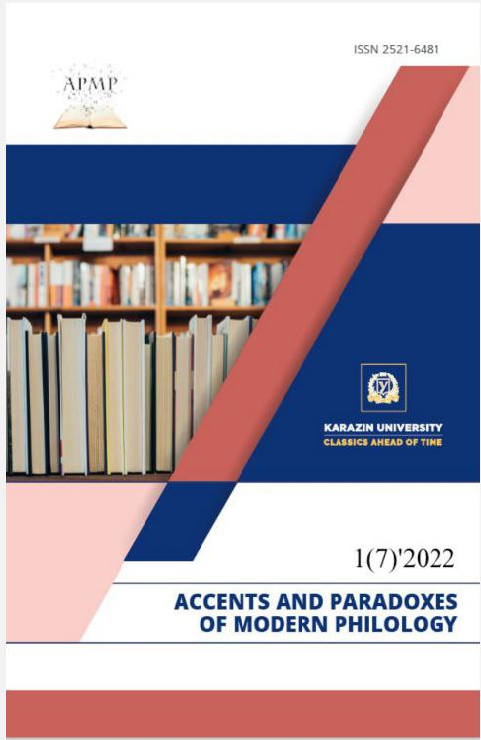TRANSFRONTALITY OF LITERARY IMAGES: EXTRAPOLATION OF THE ITALIAN PUPPET HERO PULCINELLA
Abstract
The article concerns one of the most important characters of national Italian puppet theatre, the marionette Pulcinella, and its influence on the images of folk heroes of puppet and drama theaters, street performances and literary works in European countries. National invariants of this character in the theaters and literatures of Western and Central Europe from the time of the appearance of this character to the beginning of the twentieth century are highlighted. Due to the expansion of economic and political ties, from the beginning of the 17th century, Pulcinella, together with itinerant artists and puppeteers, begins its transition to most European national folk theaters and literature. Depending on the geography of the country, its national character traits and national stereotypes, Pulcinella changes his image, his name, his behavior, and language. However, what is the most important, each national
puppet retains both external and internal features of their original predecessor, Pulcinella. Examples provided in the article prove that most of the national invariants of Pulcinella
possess his main character trait, that is, a fight against injustice and fierce criticism of authorities. Such characters as the English Punch, the Dutch Pickelgering, the French
Polychenelle and Guignol, the German and Austrian Hanswurth, the Spanish and Portuguese Don Cristobal, the Czech Kaszparek and the German Kasperle invariably pursue two main goals: to protect the wronged and to defeat the evil In each of the countries, the characters created on the prototype of Pulcinella, were warmly accepted by
the public and became very popular, especially with common people. At the same time, they differed from the original with their national coloring; they became the mouthpiece of
national character traits, national ethnic stereotypes. The article seconds the opinion of many literary scholars that the origins the marionette character of Pulcinella can be traced to the Italian folk theater hero of Maccus, mainly because Pulcinella adopts the features of that ancient character's appearance, such as an irregularly shaped head, a large hump on his back, a hooked nose, a large belly and lively shrewd eyes. With small changes and variations, these features of appearance are received not only by Pulcinella, but also by the numerous national invariants of this character in Europe. However, all these national invariants also preserve the typical traits of Pulcinella's character, such as cockiness, cunning, thirst for justice and victory in an argument. In the 19th century, the Pulcinella marionette ‘returns’ to Italy and transforms into the wooden puppet Pinocchio. Carlo Collodi’s novel becomes so popular that it is translated in many countries of the world, and the new characters modelled on Pinocchio, acquire national features, such as Zeppel Kern by the German writer Otto Julius Birbaum. This begins a new round of Pulcinella's influence on the world culture.
Downloads
References
Aaronovitch, B. (2011). Rivers of London. London: Gollancz. Bierbaum, O. J. (2014). Zäpfel Kerns Abenteuer. Berlin: Omnium Verlag. Bragaglia, A. G., Serao, M. (2001). I mille volti di una maschera. L'immagine di Pulcinella nelle tradizioni e nell'arte di tutto il mondo. Napoli: Pagano.
Caserta, C. (2006). Pulcinella. Viaggio nell'ultimo Novecento, tra favola e destino. Napoli: Edizioni Scientifiche Italiane.
César, O. y Torres Monreal, F. (2002). Historia básica del arte escénico. Madrid: Cátedra. Česká divadla (2000). Encyklopedie divadelních souborů. Praha: Divadelní ústav. Collodi, C. (2008). Le avventure di Pinocchio. Roma: Guinti Gunior.
Esposito, T. (2007). Il Museo di Pulcinella, Acerra Nostra, 2007. Feuillet, O. (1846). La Vie de Polichinelle et ses nombreuses aventures. Paris, Hetzel.
Gómez García, M. (1997). Diccionario del teatro. Madrid: Ediciones Akal.
Grano, E. (2013. Lo cunto de la bulla e de lu cuorno. Algrafica: Tetraktis MmxIII.
Hetzel, P.-J. (1874). Les méfaits de Polichinelle. Paris: Hetzel.
Krugkov, S. (2019) The life and amazing adventures of the famous Signor Pulcinella of Naples. Moskva: Khignaya Lavka. 88 p. (in rus)
Lessing, H. E. (2003). Werke und Briefe. 12 Bände in 14 Teilbänden. Berlin: Hrsg. v. Wilfried Barner Lovito, G. (2017). Pulcinella e Baudolino “maestri” dell’arte della parola e dell’affabulazione. Babel. Vol. 35, pp. 135-154.
McGhee, S. (2015). The Routledge Companion to Commedia Dell'Arte. New York, New York: Routledge.
Montano, A. (2003). Pulcinella. Dal mimo classico alla maschera moderna. Napoli: Libreria Dante & Descartes.
Paerl, H. (2002). Pulcinella. La misteriosa maschera della cultura europea. Sant'Oreste (RM): Apeiron Editori.
Plassard, D. (2015). Polichinelle, entre le rire et la mort. Filiations, ruptures et régénération d'une figure traditionnelle. Milan: Silvana editoriale.
Revilla, F. (1990). Diccionario de Iconografía. Madrid: Ediciones Cátedra.
Rudlin, J. (1994). Commedia Dell'Arte: An Actor's Handbook. London, England: Routledge.
Serafini, L. (1984). Pulcinellopedia (piccola). Milano: Longanesi & C.
Soldani, A. (2020). Il segreto di Pinocchio. La storia della "vera" Fatina e dei luoghi del burattino. Con un epistolario inedito. Con scritti di Claudia Bertocci, Maurizio Bruschi, Giulio M. Manetti. Firenze: Florence Art Edizioni.
Wagner, K. (2002). Verkehrserziehung damals und heute. 50 Jahre Verkehrskasper. Karlsruhe: Wissenschaftliche Staatsexamensarbeit (GHS).




